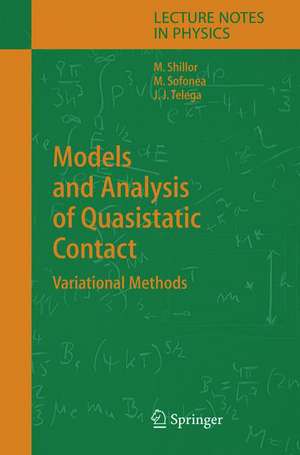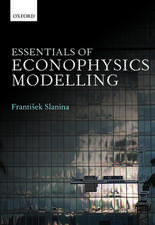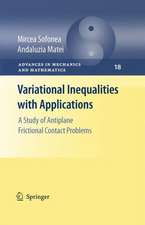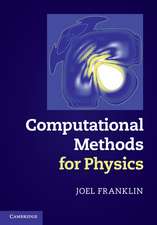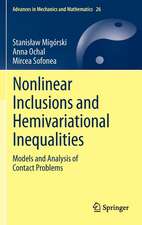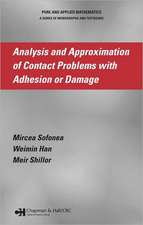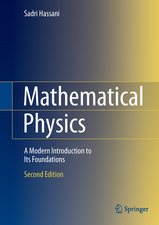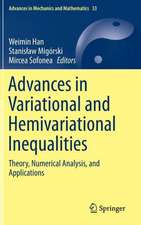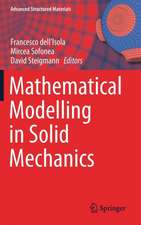Models and Analysis of Quasistatic Contact: Variational Methods: Lecture Notes in Physics, cartea 655
Autor Meir Shillor, Mircea Sofonea, Józef Joachim Telegaen Limba Engleză Hardback – 16 sep 2004
| Toate formatele și edițiile | Preț | Express |
|---|---|---|
| Paperback (1) | 639.41 lei 6-8 săpt. | |
| Springer Berlin, Heidelberg – 3 dec 2010 | 639.41 lei 6-8 săpt. | |
| Hardback (1) | 645.79 lei 6-8 săpt. | |
| Springer Berlin, Heidelberg – 16 sep 2004 | 645.79 lei 6-8 săpt. |
Din seria Lecture Notes in Physics
- 19%
 Preț: 423.99 lei
Preț: 423.99 lei - 17%
 Preț: 360.73 lei
Preț: 360.73 lei -
 Preț: 429.22 lei
Preț: 429.22 lei - 17%
 Preț: 427.62 lei
Preț: 427.62 lei - 17%
 Preț: 460.25 lei
Preț: 460.25 lei -
 Preț: 427.96 lei
Preț: 427.96 lei -
 Preț: 481.93 lei
Preț: 481.93 lei - 17%
 Preț: 494.64 lei
Preț: 494.64 lei -
 Preț: 281.90 lei
Preț: 281.90 lei - 17%
 Preț: 493.20 lei
Preț: 493.20 lei - 17%
 Preț: 426.72 lei
Preț: 426.72 lei -
 Preț: 365.15 lei
Preț: 365.15 lei -
 Preț: 374.52 lei
Preț: 374.52 lei -
 Preț: 407.98 lei
Preț: 407.98 lei - 20%
 Preț: 428.12 lei
Preț: 428.12 lei -
 Preț: 263.30 lei
Preț: 263.30 lei - 15%
 Preț: 593.73 lei
Preț: 593.73 lei - 15%
 Preț: 528.13 lei
Preț: 528.13 lei -
 Preț: 493.12 lei
Preț: 493.12 lei - 17%
 Preț: 425.68 lei
Preț: 425.68 lei -
 Preț: 280.65 lei
Preț: 280.65 lei -
 Preț: 163.41 lei
Preț: 163.41 lei - 18%
 Preț: 726.59 lei
Preț: 726.59 lei -
 Preț: 394.84 lei
Preț: 394.84 lei - 15%
 Preț: 709.63 lei
Preț: 709.63 lei - 15%
 Preț: 623.90 lei
Preț: 623.90 lei - 20%
 Preț: 476.91 lei
Preț: 476.91 lei - 15%
 Preț: 428.05 lei
Preț: 428.05 lei -
 Preț: 342.78 lei
Preț: 342.78 lei - 18%
 Preț: 851.93 lei
Preț: 851.93 lei -
 Preț: 346.61 lei
Preț: 346.61 lei -
 Preț: 391.57 lei
Preț: 391.57 lei - 15%
 Preț: 633.16 lei
Preț: 633.16 lei -
 Preț: 451.71 lei
Preț: 451.71 lei - 5%
 Preț: 1497.80 lei
Preț: 1497.80 lei -
 Preț: 374.85 lei
Preț: 374.85 lei -
 Preț: 380.07 lei
Preț: 380.07 lei - 15%
 Preț: 516.14 lei
Preț: 516.14 lei - 15%
 Preț: 583.78 lei
Preț: 583.78 lei - 15%
 Preț: 508.60 lei
Preț: 508.60 lei -
 Preț: 469.71 lei
Preț: 469.71 lei -
 Preț: 388.90 lei
Preț: 388.90 lei - 15%
 Preț: 500.24 lei
Preț: 500.24 lei -
 Preț: 386.52 lei
Preț: 386.52 lei - 15%
 Preț: 472.88 lei
Preț: 472.88 lei -
 Preț: 424.27 lei
Preț: 424.27 lei -
 Preț: 380.07 lei
Preț: 380.07 lei - 15%
 Preț: 500.01 lei
Preț: 500.01 lei
Preț: 645.79 lei
Preț vechi: 759.76 lei
-15% Nou
Puncte Express: 969
Preț estimativ în valută:
123.57€ • 129.36$ • 102.25£
123.57€ • 129.36$ • 102.25£
Carte tipărită la comandă
Livrare economică 05-19 aprilie
Preluare comenzi: 021 569.72.76
Specificații
ISBN-13: 9783540229155
ISBN-10: 3540229159
Pagini: 276
Ilustrații: XI, 263 p.
Dimensiuni: 155 x 235 x 20 mm
Greutate: 0.57 kg
Ediția:2004
Editura: Springer Berlin, Heidelberg
Colecția Springer
Seria Lecture Notes in Physics
Locul publicării:Berlin, Heidelberg, Germany
ISBN-10: 3540229159
Pagini: 276
Ilustrații: XI, 263 p.
Dimensiuni: 155 x 235 x 20 mm
Greutate: 0.57 kg
Ediția:2004
Editura: Springer Berlin, Heidelberg
Colecția Springer
Seria Lecture Notes in Physics
Locul publicării:Berlin, Heidelberg, Germany
Public țintă
ResearchCuprins
Modelling: Evolution Equations, Contact and Friction.- Additional Effects Involved in Contact.- Thermodynamic Derivation.- A Detailed Representative Problem.- Models and Their Variational Analysis: Mathematical Preliminaries.- Elastic Contact.- Viscoelastic Contact.- Viscoplastic Contact.- Slip or Temperature Dependent Frictional Contact.- Contact with Wear or Adhesion.- Contact with Damage.- Miscellaneous Problems and Conclusions: Dynamic, One-Dimensional and Miscellaneous Problems.- Conclusions, Remarks and Future Directions.- References.- Index.
Recenzii
From the reviews of the first edition:
"The aim of this important book is the study of problems in contact mechanics ... . The work is intended for a wide audience: this would include specialists in contact processes in the structural and mechanical systems … as well as those with a background in the mathematical sciences who seek a self-contained account of mathematical theory of contact mechanics. The text is suitable for graduate students and researchers in applied mathematics, computational mathematics, and computational mechanics." (J. Lovíšek, Zentralblatt MATH, Vol. 1069, 2005)
"The aim of this important book is the study of problems in contact mechanics ... . The work is intended for a wide audience: this would include specialists in contact processes in the structural and mechanical systems … as well as those with a background in the mathematical sciences who seek a self-contained account of mathematical theory of contact mechanics. The text is suitable for graduate students and researchers in applied mathematics, computational mathematics, and computational mechanics." (J. Lovíšek, Zentralblatt MATH, Vol. 1069, 2005)
Textul de pe ultima copertă
The mathematical theory of contact mechanics is a growing field in engineering and scientific computing. This book is intended as a unified and readily accessible source for mathematicians, applied mathematicians, mechanicians, engineers and scientists, as well as advanced students. The first part describes models of the processes involved like friction, heat generation and thermal effects, wear, adhesion and damage. The second part presents many mathematical models of practical interest and demonstrates the close interaction and cross-fertilization between contact mechanics and the theory of variational inequalities. The last part reviews further results, gives many references to current research and discusses open problems and future developments. The book can be read by mechanical engineers interested in applications. In addition, some theorems and their proofs are given as examples for the mathematical tools used in the models.
Caracteristici
Most of the material appears for the first time in book form An extensive bibliography gives an overview of present day research in this active field of mechanical modeling
